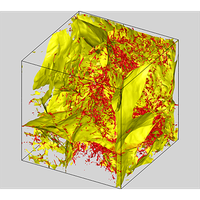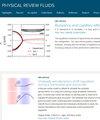可压缩湍流中的螺旋力传递
IF 2.5
3区 物理与天体物理
Q2 PHYSICS, FLUIDS & PLASMAS
引用次数: 0
摘要
研究了可压缩湍流中大尺度卷扬传递的双通道特性,包括子网格尺度(SGS)和粘性项。在选择了合适的大尺度旋涡定义之后,我们证实了大尺度旋涡调控方程中 SGS 和粘性项双通道的存在,并从理论上证明了不存在双压力项通道。SGS 和粘性项的第二通道也由两个项组成,它们分别源于 SGS 应力的旋转和速度梯度与密度梯度的巴氏。从理论和数值上可以证实,SGS 和粘性项的双通道的集合平均值的关系是相同的,而它们与冲击子有关的第二通道则更具有间歇性。就 SGS 项而言,在惯性尺度范围内,压缩区比膨胀区占优势,应变区比旋转区占优势。大尺度螺旋的粘性耗散机制与大尺度动能的粘性耗散机制不同。它由涡旋结构内部的第一通道和外部的第二通道主导。对 SGS 和粘度项的第二通道的进一步分解为反向螺旋力传递提供了可能的机制。这意味着膨胀运动通过其第二通道的第二项促进了反向螺旋度传递。本文章由计算机程序翻译,如有差异,请以英文原文为准。

Helicity transfer in compressible turbulent flows
The dual-channel characteristics of large-scale helicity transfer in compressible turbulent flows, including subgrid-scale (SGS) and viscosity terms, are investigated. After selecting a suitable definition for large-scale helicity, we confirm the existence of the dual channel of SGS and viscosity terms of large-scale helicity governing equations and theoretically prove that no dual pressure term channel exists. The second channel of the SGS and viscosity terms also consists of two terms, which originate from the rotation of the SGS stress and the baroclinic of the velocity and density gradients, respectively. The identical relationship of the ensemble averages of the dual channel of SGS and viscosity terms can be theoretically and numerically confirmed, whereas their second channel which is associated with shocklets is more intermittent. For the SGS term, the compression regions are dominant in contrast to the expansion regions, and the strain regions are dominant in contrast to the rotation regions in the inertial scale range. The viscous dissipation mechanism of large-scale helicity differs from that of large-scale kinetic energy. It is dominated by the first channel on the inside of the vortex structure and by the second channel on the outside. The further decompositions of the second channel of the SGS and viscosity terms provide a possible mechanism for the inverse helicity transfer. This means that expansion motions promote inverse helicity transfer through the second terms of their second channels.
求助全文
通过发布文献求助,成功后即可免费获取论文全文。
去求助
来源期刊

Physical Review Fluids
Chemical Engineering-Fluid Flow and Transfer Processes
CiteScore
5.10
自引率
11.10%
发文量
488
期刊介绍:
Physical Review Fluids is APS’s newest online-only journal dedicated to publishing innovative research that will significantly advance the fundamental understanding of fluid dynamics. Physical Review Fluids expands the scope of the APS journals to include additional areas of fluid dynamics research, complements the existing Physical Review collection, and maintains the same quality and reputation that authors and subscribers expect from APS. The journal is published with the endorsement of the APS Division of Fluid Dynamics.
 求助内容:
求助内容: 应助结果提醒方式:
应助结果提醒方式:


